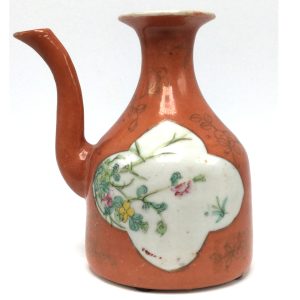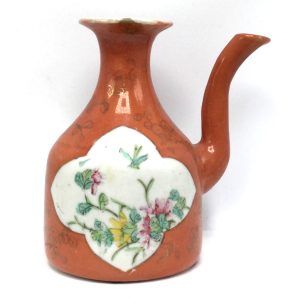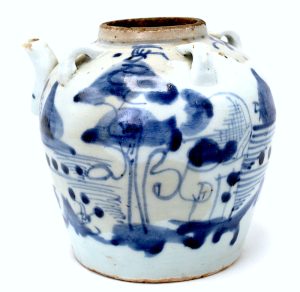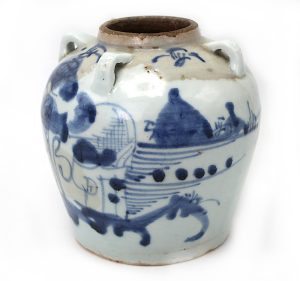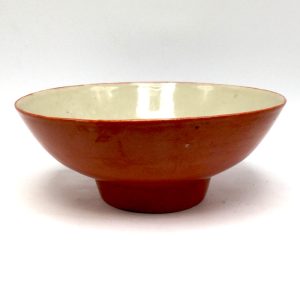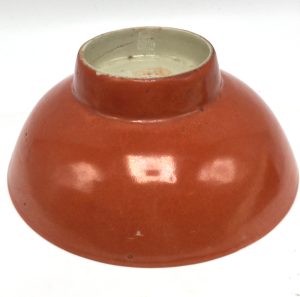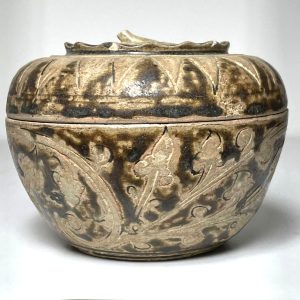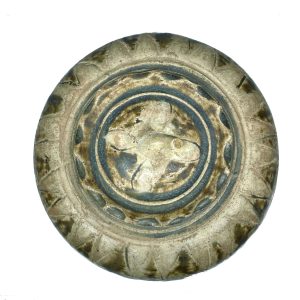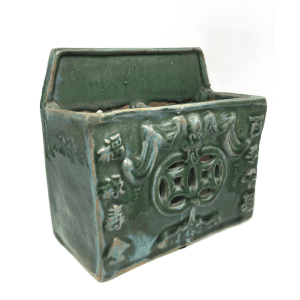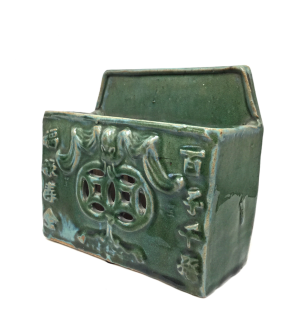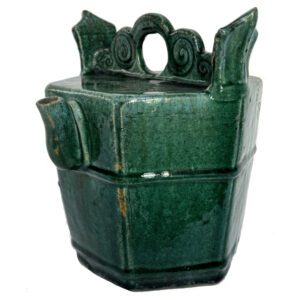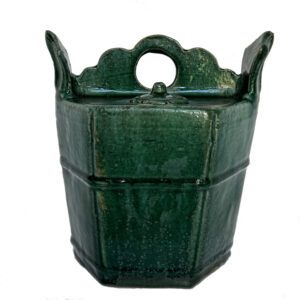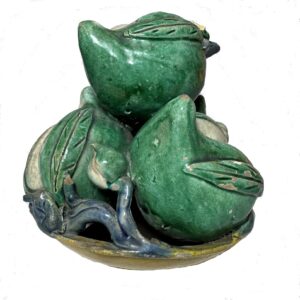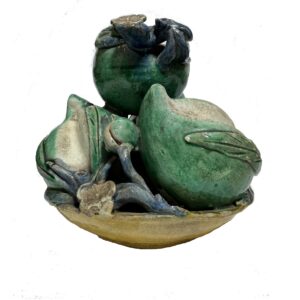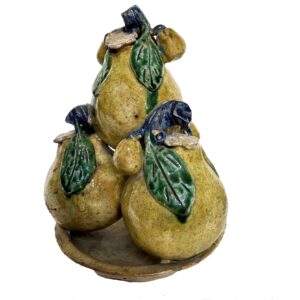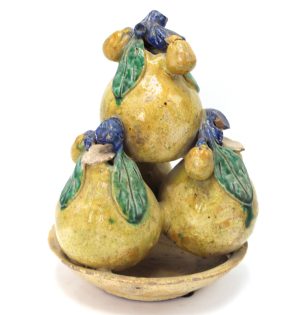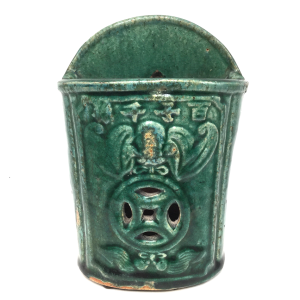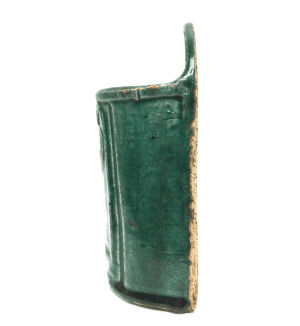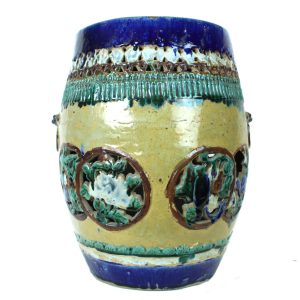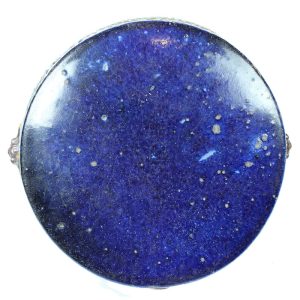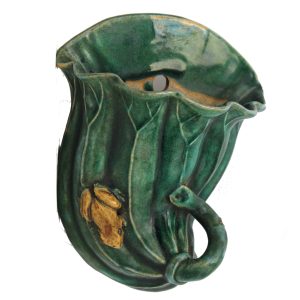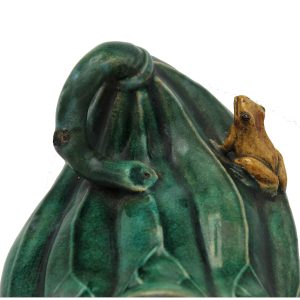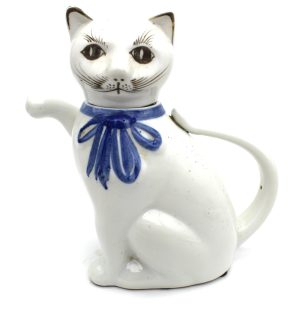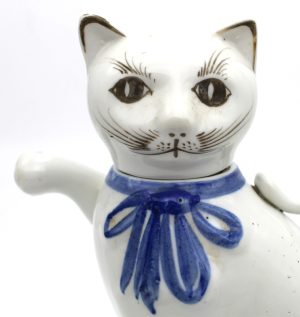Showing 25–36 of 64 results
-
Sale!


$235.00 Original price was: $235.00.$195.00Current price is: $195.00.
H: 4.875″ W: 4.5″ D: 3.25″ | FREE SHIPPING WITHIN CONtINENTAL U.S.
Elegantly shaped porcelain ewer with graceful spout, saffron-colored glaze, quatrefoil panels and hand-painted floral designs within a gold frame with sinuous gold leaf vines.
-
Sale!


$145.00 Original price was: $145.00.$105.00Current price is: $105.00.
H: 5” W: 5.25” D: 4.5” | FREE SHIPPING within continental US.
Blue and white ceramics like spouted jar with four loops, were used in home kitchens and restaurants to hold oil, sauces, soy or other liquids. Decorated with country scene in a landscape with by tall trees.
-
Sale!


$135.00 Original price was: $135.00.$110.00Current price is: $110.00.
H: 2.5” Dia: 5.75” | FREE SHIPPING WITHIN CONTINENTAL U.S.
Beautifully shaped footed porcelain bowl, thinly crafted with a coral saffron glaze on the outside on a deep foot. Fading red stamped seal of an unknown kiln on bottom. Likely from the Tongzhi Period 1862-1874.
-
Sale!


$385.00 Original price was: $385.00.$325.00Current price is: $325.00.
Ht: 3.375” Dia: 4.625” | FREE SHIPPING within continental U.S.
Sawankhalok elegant mangosteen shape stoneware lidded bowl with raised calyx, cream and brown glazes, incised floral and geometric designs to store spices, cosmetics, betel nuts and medicine.
-
Sale!


$185.00 Original price was: $185.00.$135.00Current price is: $135.00.
H: 7.125″ W: 8.375″ D: 3.75″ | FREE SHIPPING WITHIN CONTINENTAL U.S.
Shiwan 2 part chopsticks holder with top holes for hanging and bottom ones for drainage. Chopsticks were wedding gifts from mothers to daughters with auspicious wishes: sons as soon as possible, blessing for prosperity, happiness and fertility, life-giving rain and abundance.
-
Sale!


$395.00 Original price was: $395.00.$270.00Current price is: $270.00.
H: 9″ W: 8.375″ D: 5.5″ | free shipping within continental u.s.
Apple green glazed teapot typical of Shiwan kiln pottery known for its brilliant flambé glazes in the 18-19th century. Hexagonal shape with yoked rounded handle with spiral decorations that adds a decorative touch.
-
Sale!


$450.00 Original price was: $450.00.$295.00Current price is: $295.00.
Ht: 5.5” Dia: 6” | FREE SHIPPING WITHIN CONTINENTAL U.S.
Shiwan stoneware peaches and lotuses on footed bowl auspicious symbols associated with springtime, fertility, long healthy life for many generations and therefore are propitious gifts for birthdays, especially for the elderly.
-
Sale!


$375.00 Original price was: $375.00.$295.00Current price is: $295.00.
H: 8.75″ DIA: 6.75 ” | FREE SHIPPING WITHIN CONTINENTAL U.S.!
Shiwan stoneware glazed sculptures of fruit symbolizing life and new beginnings to place on temple or home altar. They augment plates of fresh stacked fresh fruit to honor ancestors. These pears symbolize long life.
-
Sale!


$115.00 Original price was: $115.00.$95.00Current price is: $95.00.
H: 7.375″ W: 5.125″ D: 2.5″ | FREE SHIPPING WITHIN CONTINENTAL U.S.
Chopsticks are ubiquitous in Chinese culture, and are often included in a bride’s dowry as a wish for a speedy arrival of many sons. This Shiwan ware green glazed wall pocket chopsticks holder has characters wishing for many sons and grandsons and an upside down bat holding a coin for “blessings in front of your eyes.”
Decorative utilitarian Shiwanware pieces are recognized for their fine modeling, vivid expression, and colorful apple-green and drip glazes. Chopsticks were commonly stored in wall pockets with a hole for mounting. Covered with auspicious symbols, they were often part of a bride’s dowry as “chopsticks” is a pun for “speedy arrival of sons.”
-
Sale!


$1,275.00 Original price was: $1,275.00.$895.00Current price is: $895.00.
H: 19.5″ DIA: 15.75″ | CALL 213-568-3030 OR EMAIL [email protected] FOR SHIPPING
Ceramic barrel shaped garden stools with cut cobalt blue auspicious double coin images as wealth symbols and 2 Tao tieh masks in relief with pierced rings to symbolically avoid gluttony, greed and desire.
-
Sale!


$285.00 Original price was: $285.00.$225.00Current price is: $225.00.
H: 8.25” W: 6.75” D: 3.5” | FREE SHIPPING WITHIN CONTINENTAL U.S.
Wall pockets are used to hold chopsticks and flowers to bring good fortune. This Shiwan pocket has frog and a lotus that together symbolize nurturing energy and transformation. Great cozy accessory for feng shui and a wonderful wedding gift.
-
Sale!


$145.00 Original price was: $145.00.$125.00Current price is: $125.00.
H: 7” W: 7” D: 3.5” | FREE SHIPPING IN CONTINENTAL US
Porcelain cat teapot removable head, sinuous tail handle. Beautifully hand-painted whimsical ribbon-like blue collar, dangling ornamental bow, and the black accents. Likely Qing Dynasty circa 1900-1920.
End of content
End of content

